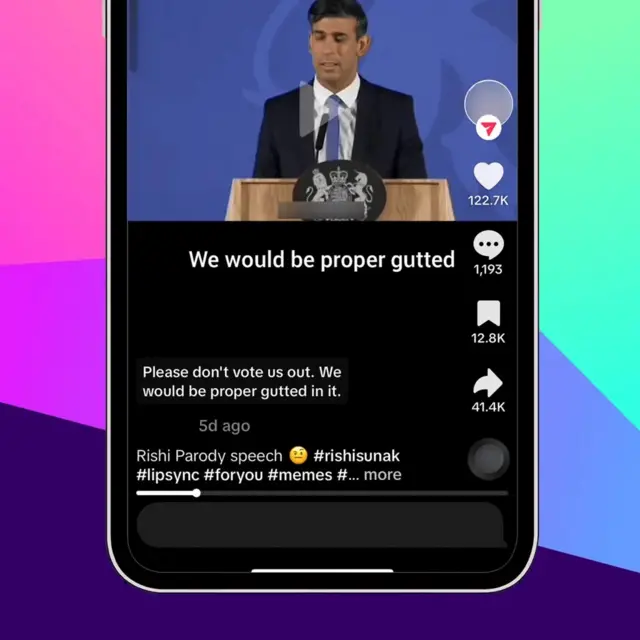Back in June, a BBC reporter discovered that young voters were browsing Tik Tok for a large number of AI-generated scandals about the current British Prime Minister, Sunnucks. The social media battleground of the UK general election was swept up in the maelstrom of public opinion.

While an AI-generated Prime Minister cannot be called an opinion leader in the technical meaning, the office of Prime Minister undoubtedly is. Being closely watched all the time, as well as his own authority, topicality and the public’s trust in him, it is easy to manipulate the minds of the masses and spread misinformed statements when they are unable to discern what is real or not, thus influencing the outcome of the election. At the same time, the content was widely distributed and shared by students, political activists, comedians and anonymous bot accounts. Opinion leaders in these groups also brought a lot of flow to the matter. Granted, the whole thing was fundamentally a trouble caused by AI synthesis, but the two-step flow theory guides the opinion leaders who pushed for the wide distribution of the event.
Based on the findings of Mulahuwaish et. al. a few highly influential users can effectively represent the views of the whole community. Is it possible to understand that people in this community have been institutionalised under the influence of opinion leaders, furthermore: ideas have been manipulated by opinion leaders.
There’s a classic line in The Shawshank Redemption: These walls are kind of funny like that. First you hate them, then you get used to them. Enough time passed, get so you depend on them. That’s institutionalized.

Prisons are the ‘discipline and punishment’ of people, however, this is true for everything that can be institutionalised, including social media.
People’s herd mentality also fuels opinion leaders’ manipulation of public opinion. In the two-step flow theory, the influence of opinion leaders often stems from their status and authority in the community. People tend to follow their views and behaviour. When we only believe what an opinion leader says, it is highly likely that people’s bias will be exacerbated by the addition of the information cocoon effect. If a person becomes an opinion leader and makes statements that are not altruistic but implied and directed, people will be easily brainwashed. Communication technology, however, has given such one-sided people the ability to converse with the world. The gap between technological advancement and human character fuels the polarisation of the group and the lack of responsibility.
People’s cognitive biases, groupthink and social influences also greatly shape our thinking. People often tend to accept information that aligns with their existing beliefs and reject dissenting voices. When people see those around them (especially opinion leaders) embracing a particular message or point of view, they are more likely to feel pressured to follow that trend. This social influence helps to increase the acceptance of certain types of information. Due to the sheer volume of information, people often rely on opinion leaders to filter and interpret information. They may believe that if an opinion or information is recognised or promoted, it has more credibility. And it is. In Tom Standage’s short history of social media, it says that humans are herd animals and crave recognition from the group. By accepting the views of opinion leaders, people can more easily integrate into a particular community and strengthen their sense of belonging.
Conclusion:
The two-level flow theory not only focuses on the dissemination of information, but also reflects the psychological and social dynamics that prevail in the process of receiving information. This mechanism allows the influence of information to be amplified, creating a stronger public opinion effect. Opinion leaders, on the other hand, have a wide range of interpersonal relationships in social networks, and their remarks can spread quickly and trigger discussions. This spreading effect means that they play the role of an amplifier in the dissemination of information. In this way, opinion leaders are able to control the audience’s emotions and opinions, and thus achieve the purpose of controlling public opinion.
Reference:
Kinanggi, S.K., Akbar, Muh. and Farid, M. (2022) ‘The role of religious leaders as opinion leaders in government communications related to covid-19’, International Journal of Science and Society, 4(4), pp. 416–427. doi:10.54783/ijsoc.v4i4.590.
LIU, F.C. (2007) ‘Constrained Opinion Leader influence in an electoral campaign season: Revisiting the two-step flow theory with multi-agent simulation’, Advances in Complex Systems, 10(02), pp. 233–250. doi:10.1142/s0219525907001008.
Mulahuwaish, A. et al. (2023) ‘Topic modeling based on two-step flow theory: Application to tweets about Bitcoin’, IT Professional, 25(2), pp. 52–63. doi:10.1109/mitp.2023.3253103.
Standage, T. (2013) Writing on the wall: Social media, the first 2,000 years. London: Bloomsbury.
Yao, Q., Li, R.Y. and Song, L. (2022) ‘Construction safety knowledge sharing on YouTube from 2007 to 2021: Two-step flow theory and semantic analysis’, Safety Science, 153, p. 105796. doi:10.1016/j.ssci.2022.105796.

